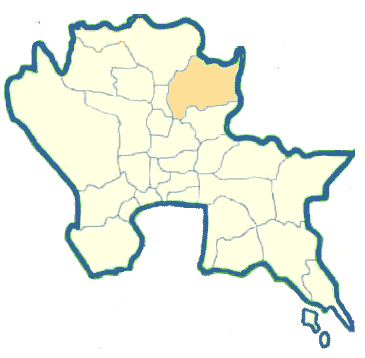Lopburi Province in Central Thailand

Lopburi is an interesting town 153 kilometers north of Bangkok. It was one of the oldest capitals of the Khmers who expanded their power to the towns of Lawo and Lopburi at the beginning of the 10th century. They ruled over the area until the middle of the 13th century when the Thais, who had already migrated from the North and settled in this country, fought them and declared independence. Since then Lop Buri has been ruled by the Thais.
Many monuments in Khmer style were constructed in Lop Buri such as the Hindu Shrine and Phra Kan Shrine.
In 1664, King Narai, a King of Ayutthaya, made Lop Buri the second capital with the help of French architects. Therefore, the architectural style of Lop Buri in the reign of King Narai was half Thai and half western, as can be seen from the Royal Palac and the Royal Reception House.
Lopburi covers an area of 6,199 square kilometers and is administratively divided into nine Amphoes(districts) and two King Amphoes(sub-districts): Muang, Ban Mi, Chai Badan, Khok Charoen, Khok Samrong, Phatthana Nikhom, Tha Luang, Tha Wung, Sa Bot, King Amphoe Lam Sonthi and King Amphoe Nong Muang.
What to see and what to do in Lopburi?
The Statue of King Narai the Great is situated at the entrance of town. King Narai the Great had Lop Buri built as the second capital and made it prosperous. He also ordered his architects and engineers to build Phra Narai Ratchaniwet Palace, pavilions, fortifications and the Buddhist sanctuary. He was the first to bring modern technology into use in the observatory and in laying terra - cotta pipes to supply water to the palace.
Apart from this, King Narai was the first Thai Monarch to establish diplomatic relations with France and impliment friendly policy towards other foreigners especially the Europeans.
Phra Prang Sam Yot, once a Hindu Shrine, is the landmark of Lop Buri and only 200 meters from the train station. It was constructed in Lop Buri Style with laterite and sandstone decorated with stucco. The adjoining prangs signify the Hindu Trinity of Brahman, Vishnu and Siva. In the reign of King Narai, the Shrine was converted to a Buddhist temple and some Buddhist designs can still be seen on it.
San Phra Kan is another Brahman shrine lying opposite Phra Prang Sam Yot and consists of two sections. The old section dates back to the Khmer period and appears in the form of a laterite mound. The new section consists of a building constructed in 1951 contains a four-armed deity figure fixed with a Buddha's head which is now the project of worship. One of the most attractive sights for the tourists visiting San Phra Kan is the great number of tamed monkeys which feed themselves on food offered to the deity by worshippers.
Prang Khaek, a charming little Khmer ruin built in the 15th century B.C., is located in the marketplace on Vichayen Rd. near Narai Ratchaniwet Palace. It was also a Hindu shrine but much smaller than Phra Prang Sam Yot. The Indian influence can be seen in its structure. This Hindu Shrine consists of three brick prangs constructed without mortar. The shrine has no corridors between each prang. It has been restored many times and is regarded as the oldest ancient monument of Lop Buri.
Wat Phra Si Maha That, located behind the railway station, is very important both in history and in archaeology. It was probably founded in the 12th century when the Khmers were governing Lop Buri. Many restorations had been done during the Ayutthaya period. What can still be seen are the ruins of numerous prangs and chedis which were built in both Sukhothai and Ayutthaya styles.
Vichayen House, located 300 meters from Prang Khaek, was constructed by King Narai as a residence for Chevalier de Chaumont, the first French ambassador to Thailand in the reign of King louis XIV. Later the place was occupied by Chao Praya Vichayen (Constant in Phaulkon) until his death at the hands of revolutionaries. There are many ruined buildings to be seen in the compound. One which served as a Roman Catholic chapel, a hall of residence for the ambassador and residences for members of the foreign mission. Ruins of water tanks made of bricks and fountains can also be seen within the compound.
Narai Ratchaniwet Palace, built by King Narai of Ayutthaya, took 12 years to be completed (1665-1677). It is located in the center of the town between Ratchadamnoen Rd. and Pratu Chai Road, which is not too faraway from the railway station. Most of the structures of the Palace are of King Narai's period. Now the whole compound has been turned into the National Museum of Lop Buri. Apart from ancient art objects displayed in the Museum, every pavilion in the royal palace has an interesting history.
Wat San Paulo is situated 3 kilometers east of town. It was a church of the Jesuits, founded during the reign of King Narai. Now only a brick wall of a high tower behind the church still remains. The Thai word, "San Paulo" was probably derived from "Saint Paul" or "Saint Paulo".
Wat Sao Thong Thong is north of the Royal Palace. The Vihara and the main Buddha image were created in the Ayutthaya period. Later, King Narai restored this manastery and changed the windows of the Viharn to western style.
The largest sunflower field in Thailand is located in Tambon Chong Sarika, Amphoe Phatthana Nikom. Travel 30 kilometers along Lop Buri-Saraburi Road, then turn left onto Highway No.21 and travel 15 kilometers. The beautiful sunflower fields have become a tourist attraction when the sun flowers are in full blossom from November to January.
Wang Kan Luang Waterfall is about 12 kilometres from Lam Narai Market, in Amphoe Chai Badan. It appeals as a quiet and refreshing retreat from the city, suitable for family visitors.
